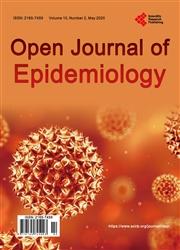Seasonal Effect of Sunlight on COVID-19 among Countries with and without Lock-Downs
引用次数: 3
Abstract
Objective: The main aim of the study was to determine whether COVID-19 epidemiological data reported by countries in different hemispheres correlated with the seasons of the year. Since stay-at-home orders could be a main factor affecting the time individuals spent outdoors, the progression of COVID-19 in countries that mandated the most stringent lock-downs and stay-at-home orders was compared to countries in the same hemisphere that did not order their citizens to remain at home. Methods: Infections attributed to COVID-19 per million inhabitants, deaths per infections × 100, and deaths per million inhabitants from different countries were analyzed utilizing national reports registered in the Johns’ Hopkins database together with the most recent world population data. The null hypothesis (no difference between countries with and without lock-downs) was tested (two tailed test, p Results: The shift of highest infection rates from countries in the northern-towards countries in the southern-hemisphere during early 2020 and the reverse in December of the same year correlates with the seasonal variation in the flux of germicidal sunlight. Mortality rate for the same virus among different countries did not show a seasonal component. COVID-19 infection mortality rate was considerably lower in developing countries of South America (11 of the largest countries) than in several (at least 8) developed European countries. Discussion: COVID-19 resulted in higher infections during winter than in summer. The finding of a seasonal component, correlating the progression of the pandemic with local solar flux, demonstrates that infectious virus in the environment plays a role in the pandemic since direct person-to-person transmission would afford little time for solar inactivation. Similar epidemiological data amongst “locked” and “unlocked” countries demonstrates that lock-downs and similar confining measures had no effect on the chances of healthy individuals becoming infected with SARS-CoV-2 or dying of COVID-19.在有和没有封城的国家,阳光对COVID-19的季节性影响
目的:本研究的主要目的是确定不同半球国家报告的COVID-19流行病学数据是否与一年中的季节相关。由于居家令可能是影响个人户外活动时间的主要因素,因此将实施最严格的封锁和居家令的国家与同一半球未命令其公民留在家中的国家的COVID-19进展进行了比较。方法:利用约翰霍普金斯大学数据库中登记的国家报告以及最新的世界人口数据,分析来自不同国家的每百万居民的COVID-19感染、每感染× 100的死亡人数和每百万居民的死亡人数。对零假设(有和没有封锁的国家之间没有差异)进行了检验(双尾检验,p)。结果:2020年初,最高感染率从北半球国家向南半球国家转移,同年12月则相反,这与杀菌阳光通量的季节性变化有关。同一种病毒在不同国家的死亡率没有显示出季节性成分。南美洲发展中国家(11个最大的国家)的COVID-19感染死亡率远低于几个(至少8个)欧洲发达国家。讨论:COVID-19导致冬季感染人数高于夏季。季节性因素的发现,将大流行的进展与当地太阳通量联系起来,表明环境中的传染性病毒在大流行中发挥了作用,因为直接人与人之间的传播几乎没有时间使太阳灭活。“封锁”和“未封锁”国家之间类似的流行病学数据表明,封锁和类似的限制措施对健康个体感染SARS-CoV-2或死于COVID-19的几率没有影响。
本文章由计算机程序翻译,如有差异,请以英文原文为准。
求助全文
约1分钟内获得全文
求助全文

 求助内容:
求助内容: 应助结果提醒方式:
应助结果提醒方式:


